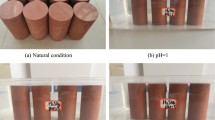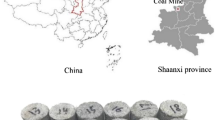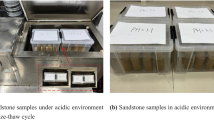Abstract
The influence of water–rock interaction in the process of coal mine construction cannot be ignored, especially when the groundwater quality is complex and contains acidic substances. In this paper, considering the influence of mining, blasting, and earthquake, the dynamic mechanical properties and fractal characteristics of sandstone under acid dry–wet cycle were studied. A comprehensive method combining X-ray diffraction (XRD), scanning electron microscopy (SEM), and energy dispersive spectrometer mapping (EDS Mapping) technology for chemical damage analysis was established, and the damage mechanism of sandstone was summarized. The test results show that the acid dry–wet cycle has a great influence on the dynamic peak stress of sandstone (σd) and elastic modulus (Ed) is higher than neutral. And with the decrease of pH value of acidic solution, σd and Ed decrease and the peak strain increases, indicating that the acid solution has corrosion and softening effect on sandstone. With the increase of acid dry–wet cycles, the fractal dimension increases linearly. Sandstone fragments show more broken blocks and smaller particle sizes. Microscopic comprehensive analysis shows that acid solution (H2SO4) will preferentially react with metal oxides and salt cements to open rock pores, and gypsum (CaSO4) and other products will be formed in the process. In the process of the acid dry–wet cycle, the sandstone is corroded by acid solution, which leads to pore growth. Meanwhile, the dry–wet cycle causes repeated expansion and contraction of rock particles. Both of them accelerate rock failure.
Highlights
-
(1)
Acid solution weakens the dynamic mechanical parameters of rock, softens the specimen and increases the post-peak strain.
-
(2)
With the increase of cycles, the fractal dimension of sandstone increases linearly, and the lower the pH, the more fragmentation and the smaller the particle size.
-
(3)
The damage caused by the acid dry-wet cycle to the rock consists of two parts: physical and chemical.





















Similar content being viewed by others
References
Arizio E, Orsega EF, Sommariva G, Falcone R (2013) Tin amalgam mirrors: investigation by XRF, SEM-EDS, XRD and EPMA-WDS mapping. Appl Phys A 111(3):733–745
Cai X, Zhou Z, Tan L, Zang H, Song Z (2020a) Fracture behavior and damage mechanisms of sandstone subjected to wetting -drying cycles. Eng Fract Mech 234:107109
Cai X, Zhou Z, Zang H et al (2020b) Water saturation effects on dynamic behavior and microstructure damage of sandstone: phenomena and mechanisms. Eng Geol 276:105760
Cai X, Cheng Q, Zhou Z et al (2021) Rock mass watering for rock-burst prevention: some thoughts on the mechanisms deduced from laboratory results. Bull Eng Geol Env. https://doi.org/10.1007/s10064-021-02467-0
Chang H, Cheng C, Huang P, Lin S (2014) Application of scanning electron microscopy and X-ray microanalysis: FE-SEM, ESEM-EDS, and EDS mapping for studying the characteristics of topographical microstructure and elemental mapping of human cardiac calcified deposition. Anal Bioanal Chem 406(1):359–366
Chen L, Iyengar S, Zhou J, Turba K, Stahl J (2015) Characterization of microstructure and mechanical properties of high chromium cast irons using SEM and nanoindentation. J Mater Eng Perform 24(1):98–105
Chen Z, Shao X, Xu X, He X (2018) Optimized digital speckle patterns for digital image correlation by consideration of both accuracy and efficiency. Appl Optics 57(4):884–893
Ciantia MO, Castellanza R, Crosta GB, Hueckel T (2015) Effects of mineral suspension and dissolution on strength and compressibility of soft carbonate rocks. Eng Geol 184:1–18
Critelli T, Marini L, Schott J et al (2014) Dissolution rates of actinolite and chlorite from a whole-rock experimental study of metabasalt dissolution from 2 <= pH <= 12 at 25 degrees C. Chem Geol 390:100–108
Dehestani A, Hosseini M, Beydokhti AT (2020) Effect of wetting-drying cycles on mode I and mode II fracture toughness of sandstone in natural (pH=7) and acidic (pH=3) environments. Theor Appl Fract Mec 107:102512
Deng H, Xiao Z, Li J, Hu Y, Zhou M (2015) Deteriorating change rule test research of damage sandstone strength under water-rock interaction. Chin J Rock Mech Eng (chin) 34(1):2690–2698
Du B, Bai H (2019) A damage constitutive model of red sandstone under coupling of wet-dry cycles and impact load. Shock Vib 2019:7692424
Du B, Bai H, Wu G (2019) Dynamic compression properties and deterioration of red-sandstone subject to cyclic wet-dry treatment. Adv Civ Eng 2019:1487156
Fang J, Deng H, Qi Y, Xiao Y, Zhang H, Li J (2019) Analysis of changes in the micromorphology of sandstone joint surface under dry-wet cycling. Adv Mater Sci Eng 2019:8758203
Feng X, Ding W, Cui Q (2010) Coupled chemical-stress effect on rock fracturing process. Science Press, Beijing
Gan ZQ, Pan X, Tang HZ et al (2021) Experimental investigation on mixed mode I-III fracture characteristics of sandstone corroded by periodic acid solution. Theor Appl Fract Mech 114:103034
Guo Q, Su H, Jing H, Zhu W (2020) Effect of wetting-drying cycle on the deformation and seepage behaviors of rock masses around a tunnel. Geofluids 2020:4237163
Han G, Jing H, Liu R, Su H, Wu J, We J (2019a) Experimental investigation on the mechanical behavior of red sandstone under the coupled effects of temperature and acidic etching. Arab J Geosci 12:58618
Han T, Wang X, Li D, Li D, Han N, Xing F (2019b) Damage and degradation mechanism for single intermittent cracked mortar specimens under a combination of chemical solutions and dry-wet cycles. Constr Build Mater 213:567–581
He LP, Yu JY, Hu QJ, Cai QJ, Qu MF, He TJ (2020) Study on crack propagation and shear behavior of weak muddy intercalations submitted to wetting-drying cycles. B Eng Geol Environ 79(9):4873–4889
Hu M, Liu Y, Ren J, Wu R, Zhang Y (2019) Laboratory test on crack development in mudstone under the action of dry-wet cycles. B Eng Geol Environ 78(1):543–556
Huang X, Pang J, Liu G, Chen Y (2020) Experimental study on physicomechanical properties of deep sandstone by coupling of dry-wet cycles and acidic environment. Adv Civ Eng 2020:2760952
ISRM (1981) Method for determining uniaxial compressive strength and deformability of rock materials rock characterization testing and monitoring. Int J Rock Mech Min Sci 18(6):113–116
Jiang Q, Deng H, Li J et al (2019) The degradation effect and mechanism by water-rock interaction in the layered sandstone in the three gorges reservoir area. Arab J Geosci 12:72223
Li S, Li C, Yao W et al (2019) Impact of wetting-drying cycles on dynamic tensile strength of rock. Therm Sci 233:815–820
Li Y, Zhang S, Zhang X (2018) Classification and Fractal Characteristics of Coal Rock Fragments Under Uniaxial Cyclic Loading Conditions. Arab J Geosci 11:2019
Liang H, Fu Y (2020) Fracture properties of sandstone degradation under the action of drying-wetting cycles in acid and alkaline environments. Arab J Geosci 13:2
Liang H, Yuan W, Fu Y et al (2021) Degradation law of mixed-mode (I/II) fracture toughness of sandstone under drying-wetting cycles in acid and alkaline environments. Arab J Geosci 14(14):1312
Liu J, Wang Z, Hu S (1998) The SHPB experiment technology for low wave impedance porous materials. J Exp Mech (chin) 13(2):3–5
Liu X, Wang Z, Fu Y, Yuan W, Miao L (2016) Macro/microtesting and damage and degradation of sandstones under dry-wet cycles. Adv Mater Sci Eng 2016:7013032
Liu X, Yuan W, Fu Y, Wang Z, Miao L, Bw X (2018a) Porosity Evolution of Sandstone Dissolution Under Wetting and Drying Cycles. Chin J Geotech Eng (chin) 40(3):527–532
Liu X, Jin M, Li D, Zhang L (2018b) Strength deterioration of a shaly sandstone under dry-wet cycles: a case study from the three gorges reservoir in China. B Eng Geol Environ 77(4):1607–1621
Liu W, Song X, Huang F, Hu L (2019) Experimental Study on the disintegration of granite residual soil under the combined influence of wetting-drying cycles and acid rain. Geomat Nat Haz Risk 10(1):1912–1927
Liu G, Huang X, Pang J (2020) The uniaxial creep characteristics of red sandstone under dry-wet cycles. Adv Civ Eng 2020:8841773
Lu P, Romero E, Lee S, Macmanus-Driscoll JL, Jia Q (2014a) Chemical quantification of atomic-scale EDS maps under thin specimen conditions. Microsc Microanal 20(6):1782–1790
Lu P, Zhou L, Kramer MJ, Smith DJ (2014b) Atomic-scale chemical imaging and quantification of metallic alloy structures by energy-dispersive X-Ray spectroscopy. Sci Rep-UK 4:3945
Ma J, Niu X, Xiong C et al (2020) Experimental investigation of the physical properties and microstructure of slate under wetting and drying cycles using micro-CT and ultrasonic wave velocity tests. Sens (basel, Switzerl) 20:17
Meng B, Jing H, Zhu W, Su H (2019) Influences of saturation and wetting-drying cycle on mechanical performances of argillaceous limestones from liupanshan tunnel, China. Adv Mater Sci Eng 2019:9236172
Newbury DE, Ritchie NWM (2013) Elemental mapping of microstructures by scanning electron microscopy-energy dispersive X-ray spectrometry (SEM-EDS): extraordinary advances with the silicon drift detector (SDD). J Anal Atom Spectrom 28(7):973–988
Shan S, Li Z (2003) Fractal theory, characteristics and its application on rock fragmentation. J Hebei Inst Technol Chin 25(2):11–17
Song L, Hu S (2005) Two-wave and three-wave method in SHPB data processing. Explos Shock Waves Chin 25(4):368–373
Song Z, Ji H, Jiang H, Liu Z, Wang H, Liu Y (2018) Influence of wetting-drying cycles on acoustic emission characteristics and mi-crostructure deterioration of weak cementation stratum. J China Coal Soc Chin 43(1):96–103
Sun Q, Zhang Y (2019) Combined effects of salt, cyclic wetting and drying cycles on the physical and mechanical properties of sandstone. Eng Geol 248:70–79
Titus MS, Mottura A, Viswanathan GB, Suzuki A, Mills MJ, Pollock TM (2015) High resolution energy dispersive spectroscopy mapping of planar defects in L1(2)-containing co-base superalloys. Acta Mater 89:423–437
Uvarov V, Popov I, Shapur N et al (2011) X-ray diffraction and SEM study of kidney stones in Israel: quantitative analysis, crystallite size determination, and statistical characterization. Environ Geochem Hlth 33(6):613–622
Wang Z, Zhu Z, Sun X, Wang X (2017) Deterioration of fracture toughness of concrete under acid rain environment. Eng Fail Anal 77:76–84
Wu X, Zhu B, Luo J (2008) Weathering process of black rock stratum and its thermodynamic analysis. Science Press, Beijing
Xu J, Liu S (2012) Research on fractal characteristics of marble fragments subjected to impact loading. Rock Soil Mech Chin 33(11):3225–3229
Yuan P, Ma Q, Zhang H (2014) SHPB tests for light weight foam concrete. J Vibr Shok Chin 17:116–119
Yuan W, Liu X, Fu Y (2019a) Chemical thermodynamics and chemical kinetics analysis of sandstone dissolution under the action of dry-wet cycles in acid and alkaline environments. B Eng Geol Environ 78(2):793–801
Yuan P, Wei N, Ma Q, Chang J (2019b) Coupled effect of water temperature and cyclic wetting and drying on dynamic mechanical characteristics of sandstone. Adv Civ Eng 2019:8167651
Zhang R, Ma D, Su Q, Huang K (2020) Effects of temperature and water on mechanical properties, energy dissipation, and microstructure of argillaceous sandstone under static and dynamic loads. Shock Vib 2020:8827705
Zhao Y, Ren S, Jiang D, Liu R, Wu J, Jiang X (2018) Influence of wetting-drying cycles on the pore structure and mechanical properties of mudstone from simian mountain. Constr Build Mater 191:923–931
Zhou Z, Cai X, Chen L, Cao W, Zhao Y, Xiong C (2017) Influence of cyclic wetting and drying on physical and dynamic compressive properties of sandstone. Eng Geol 220:1–12
Zhou Z, Cai X, Ma D, Chen L, Wang S, Tan L (2018) Dynamic tensile properties of sandstone subjected to wetting and drying cycles. Constr Build Mater 182:215–232
Zhou Z, Cai X, Li X et al (2020) Dynamic response and energy evolution of sandstone under coupled static-dynamic compression: insights from experimental study into deep rock engineering applications. Rock Mech Rock Eng 53(3):1305–1331
Acknowledgements
The authors acknowledge the School of Civil Engineering and Architecture, Anhui University of Science and Technology for their support to perform this research.
Funding
None.
Author information
Authors and Affiliations
Contributions
XH performed the experiments and analyzed the test data; XH wrote the manuscript; JP conceived the experiment and provided guidance and suggestion. JZ provided important guidance in the process of experimental design, micro-image analysis, and paper modification.
Corresponding authors
Ethics declarations
Conflicts of interest
The authors declare no conflicts of interest.
Additional information
Publisher's Note
Springer Nature remains neutral with regard to jurisdictional claims in published maps and institutional affiliations.
Rights and permissions
About this article
Cite this article
Huang, X., Pang, J. & Zou, J. Study on the Effect of Dry–Wet Cycles on Dynamic Mechanical Properties of Sandstone Under Sulfuric Acid Solution. Rock Mech Rock Eng 55, 1253–1269 (2022). https://doi.org/10.1007/s00603-021-02729-z
Received:
Accepted:
Published:
Issue Date:
DOI: https://doi.org/10.1007/s00603-021-02729-z




